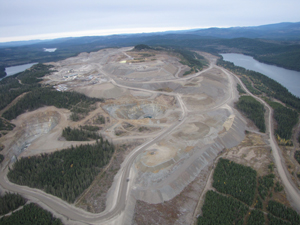
On March 26, 2014, the Williams Lake Tribute ran a story headlined "Mount Polley keeps growing." Who could have imagined the tailings pond dam would burst less than five months later?
The Tribune story quoted Mount Polley Mining Corporation project engineer Luke Moger saying: "They didn't know how big the mine was going to be when it first started so in order to keep the tailings storage facility here they had to add this dam and in the last few years added another dam on the other end." In the months ahead, attention will focus on whether the growing in the tailings pond was properly managed.
Did government negligence play a role in the Mount Polley tailings dam failure? On Feb. 10, 2011, a letter was sent from Knight Piésold to Mount Polley Mining Corporation in which it resigned as Engineer of Record and cautioned: "The embankments and the overall tailings impoundment are getting large and it is extremely important that they be monitored, constructed and operated properly to prevent problems in the future."
The letter was copied to the province's Chief Inspector of Mines, and if the "cc" wasn't clear enough, the text drew attention to that notification saying: "As we have a long relationship with the Mines Branch and the Ministry of Energy, Mines and Petroleum Resources, we consider that it is prudent to notify them of the change in status. Therefore, we have copied them on this correspondence."
Did anyone in the Mines Branch pay extra attention to the Mount Polley tailings pond after receipt of the Knight Piésold letter, or was it business as usual? I have submitted a freedom of information request in an effort to discover whether the letter produced any action in government. Given the public importance of understanding why the dam failed, I hope the information request doesn't result in the customary stalls, requests for fees and ultimately stacks of banked out paper.
The premier has been criticized for her slow initial response to the disaster; now is the time to be completely transparent. The Ministry of the Environment is providing regular updates on a website devoted to Mount Polley; the Ministry of Energy and Mines needs to be equally transparent with respect to its role, especially its role since it received the Knight Piésold letter.
Who'll pay to clean up?
It is understandable that attention is initially focused on providing support to people affected by what a government release calls the Mount Polley "incident." Services need to be restored and the extent of the environmental degradation needs to be determined. However, that isn't stopping those who have suffered economic loss from initiating action. An investor class action has been commenced. It wouldn't be surprising if resort operators and others who have suffered economic loss also commence litigation. In the absence of an independent investigation into the circumstance that led to the failure of the tailings dam near Likely, B.C. on Aug. 4, 2014, we may have to wait to hear evidence in court in order for all the facts to come out.
Both Bill Bennett, minister of Energy and Mines, and Mary Polak, minister of Environment, have been careful not to criticize the company. In an interview on CKNW on Aug. 10, Polak said she is confident Imperial Metals has sufficient resources to pay for the cleanup. (Mount Polley Mining Corporation is a wholly-owned subsidiary of Imperial Metals Corporation.)
The company's last annual financial statements reported equity of $418 million as of Dec. 31, 2013. It remains to be seen if that is sufficient financial strength to cover the litigation and pay for the cleanup. Don't be surprised if the province is drawn into any litigation and ends up paying part of the cleanup costs. ![]()
Read more: Energy, BC Politics, Environment














Tyee Commenting Guidelines
Comments that violate guidelines risk being deleted, and violations may result in a temporary or permanent user ban. Maintain the spirit of good conversation to stay in the discussion.
*Please note The Tyee is not a forum for spreading misinformation about COVID-19, denying its existence or minimizing its risk to public health.
Do:
Do not: